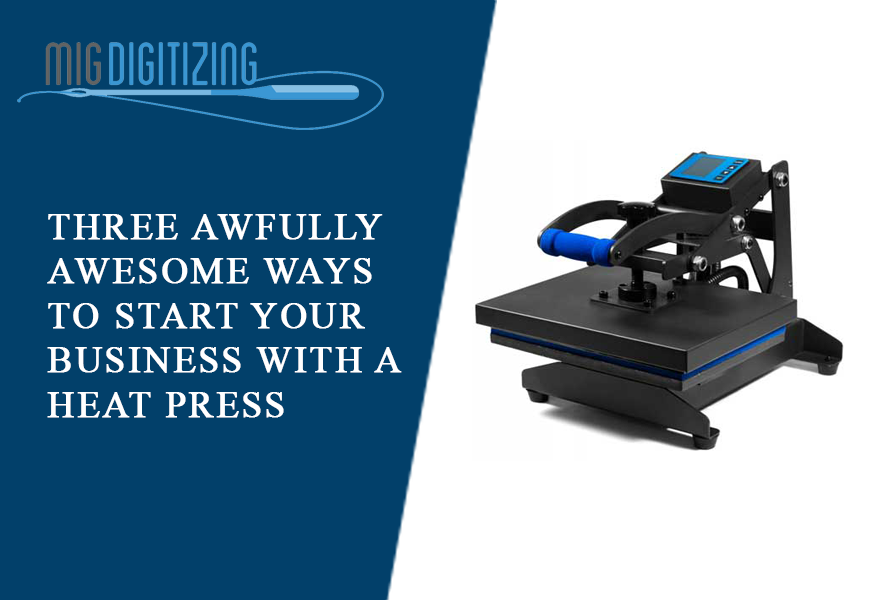
Have you at any point needed to begin a productive custom clothing business or side hustle, yet didn't have the foggiest idea where to start? In this blog, we'll cover the best 3 different ways to bring in cash utilizing a warmth press. With the entirety of the distinctive gear to browse, the decision can be overpowering, which is the place where we come in.
We'll even position them from the most affordable to a most costly alternative so you can get beginning bringing in cash squeezing orders as quickly as time permits. The following are the techniques that we'll cover. With five custom printing strategies to look over, you will undoubtedly track down the ideal method to begin that business or side hustle you've generally needed.
There is an assortment of heat press to look over, going from level warmth squeezes that can engrave plans on shirts, sacks and coats, to strength heat squeezes that can print on mugs, water bottles, beautiful plates, covers thus significantly more. Warmth press machines are utilized for all times engrave plans and illustrations onto custom pieces of clothing by applying warmth and pressing factor all the while for a preset timeframe.
Here are the most generally utilized warmth presses:
Plate heat press: Used for brightening plates or liners and other little, level things.
Mug heat press: Perfect for enhancing or dedicatory cups of different sizes.
Cap heat press: Used for imprinting on covers and even face veils!
Level warmth press: Perfect for t-shirts, coats, napkins, mousepads and other level things.
Direct to Garment Printing (DTG)
You should simply line the plan up in the printing programming and burden your pre-treated article of clothing onto the printer's platen and afterwards press start. It's that simple. Direct to the article of clothing printing, or DTG for short is one of the least demanding shirt printing techniques since it reenacts an ordinary office printer. DTG printers are more costly than the past heat-move printing alternatives that we've covered, yet they are the clearest.
Also, the bundle at Ricoma accompanies a warmth press previously included alongside the entirety of different supplies that you'll have to begin. With a portion of different strategies recorded, the solitary gear you'd need is simply the warmth press, however with DTG, you'll simply utilize the warmth press to fix the piece of clothing after the DTG printer is finished printing. With this technique, the warmth press is important yet optional to the DTG printer itself.
2-Step Heat Transfer and Sublimation
This is quite possibly the most fascinating shirt printing alternative accessible on the grounds that it accomplishes something no other strategy can—It frames lasting security with the substrate you use it on. The second strategy that we'll examine in this part is called sublimation. As its name infers, this cycle is designated "2-venture" since it finds a way two ways to make the exchange sheet you need to press the plan onto an article of clothing.
The gear and supplies required for 2-venture heat move and sublimation are basically the same in cost and in some cases should be possible to utilize a similar printer. When the cement has been moved to your plan sheet, you would then be able to utilize your warmth press to cling your plan to your material.
You'll initially need to print your plan onto clear exchange paper, at that point heat press the unmistakable sheet with your plan on it with a cement sheet, or sublimation paper, to make your last exchange sheet.
You will just have to program your plan into the product and print however many exchanges as you need for the request and essentially press them onto your article of clothing, which drives us to the aces of this interaction. Albeit the expense of the printer is more costly than HTV, with this interaction, you won't have to invest energy weeding your plans before each print.
You'll likewise profit by making handicrafts that are for all time clung to your piece of clothing when utilizing sublimation, which can prompt higher net revenues as you can charge a touch more for your things.
Heat Transfer Vinyl
Warmth move vinyl, otherwise called HTV, is the point at which you cut out a vinyl plan and move it onto texture utilizing a warmth press. Join that with the minimal expense of provisions and materials, and you'll probably see high-overall revenues.
However, before we get into production, we should rapidly go over the expense of materials related to Heat-Transfer Vinyl Printing, which will at that point assist us with deciding our benefit. With alternatives to print on a wide range of substrates, including wood, glass, clay, texture and that's only the tip of the iceberg, you'll have the option to offer a wide determination of items.
Besides hardware costs, vinyl is additionally more "work concentrated" than essential warmth moves, which could likewise add to your creation time, particularly in the event that you are utilizing various shadings and making different articles of clothing as each plan should be "weeded" or cut out by hand prior to squeezing.
Finally, you'll need a weeding apparatus, which is a moderately cheap device averaging at about $10 per unit. We'll go over this instrument and what it's utilized for somewhat later. Remember that the above equation relies upon the expense of your hardware.
Picking more affordable hardware will help you take care of your gear quicker. Vinyl cutters are commonly more affordable than move printers or sublimation printers, making it the most mainstream adornment strategy for crafters and amateurs.
Nonetheless, in light of the fact that it doesn't loan itself well to printing bigger groups all the more rapidly, HTV things are more appropriate for custom oddball orders or a little clump of comparative plans that you can sell on Etsy or another online shop. If you want to know more anything about the topic or anything related to embroidery digitizing, feel free to contact us.



